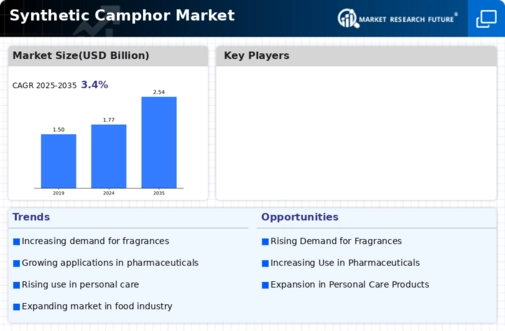Market Growth Projections
The Global Synthetic Camphor Market Industry is projected to experience substantial growth, with estimates indicating a market value of 1.77 USD Billion in 2024 and an anticipated increase to 2.54 USD Billion by 2035. This growth trajectory suggests a robust demand for synthetic camphor across various sectors, including pharmaceuticals, personal care, and food industries. The compound annual growth rate (CAGR) of 3.35% from 2025 to 2035 further underscores the market's potential, reflecting the ongoing innovations and applications of synthetic camphor in diverse fields.
Expansion of the Food Industry
The Global Synthetic Camphor Market Industry is also influenced by its applications in the food sector, where it serves as a flavoring agent and preservative. As global food production and consumption continue to rise, the demand for synthetic camphor in food processing is expected to increase. This is particularly relevant in regions where food safety and preservation are paramount. The anticipated growth in this sector contributes to the overall market value, which is projected to reach 2.54 USD Billion by 2035, highlighting the importance of synthetic camphor in enhancing food quality and safety.
Growth in Personal Care Products
The Global Synthetic Camphor Market Industry benefits from the increasing incorporation of synthetic camphor in personal care products. Its unique properties make it a popular ingredient in cosmetics, fragrances, and skincare formulations. As consumer preferences shift towards products that offer both efficacy and sensory appeal, manufacturers are likely to enhance their formulations with synthetic camphor. This trend aligns with the overall market growth, which is projected to expand at a CAGR of 3.35% from 2025 to 2035, reflecting the rising consumer demand for innovative personal care solutions.
Regulatory Support and Standards
The Global Synthetic Camphor Market Industry is positively impacted by regulatory support and established standards that govern the use of synthetic camphor in various applications. Governments and regulatory bodies are increasingly recognizing the safety and efficacy of synthetic camphor, leading to its acceptance in pharmaceuticals, cosmetics, and food products. This regulatory backing not only fosters consumer confidence but also encourages manufacturers to innovate and expand their product lines. As a result, the market is expected to thrive, with a projected value of 1.77 USD Billion in 2024, paving the way for future growth.
Rising Demand in Pharmaceuticals
The Global Synthetic Camphor Market Industry experiences a notable surge in demand from the pharmaceutical sector. Synthetic camphor is utilized in various medicinal formulations, particularly in topical applications for its analgesic and anti-inflammatory properties. As the global population ages and the prevalence of chronic diseases increases, the need for effective pain relief solutions is likely to grow. This trend is further supported by the projected market value of 1.77 USD Billion in 2024, with expectations to reach 2.54 USD Billion by 2035, indicating a robust growth trajectory fueled by the pharmaceutical industry's expansion.
Technological Advancements in Production
Technological advancements in the production of synthetic camphor are poised to drive the Global Synthetic Camphor Market Industry forward. Innovations in manufacturing processes can lead to increased efficiency, reduced costs, and improved product quality. As companies adopt more sustainable practices and invest in research and development, the market is likely to benefit from enhanced production capabilities. This evolution may support the projected CAGR of 3.35% from 2025 to 2035, as businesses strive to meet the growing demand for synthetic camphor across various applications.











